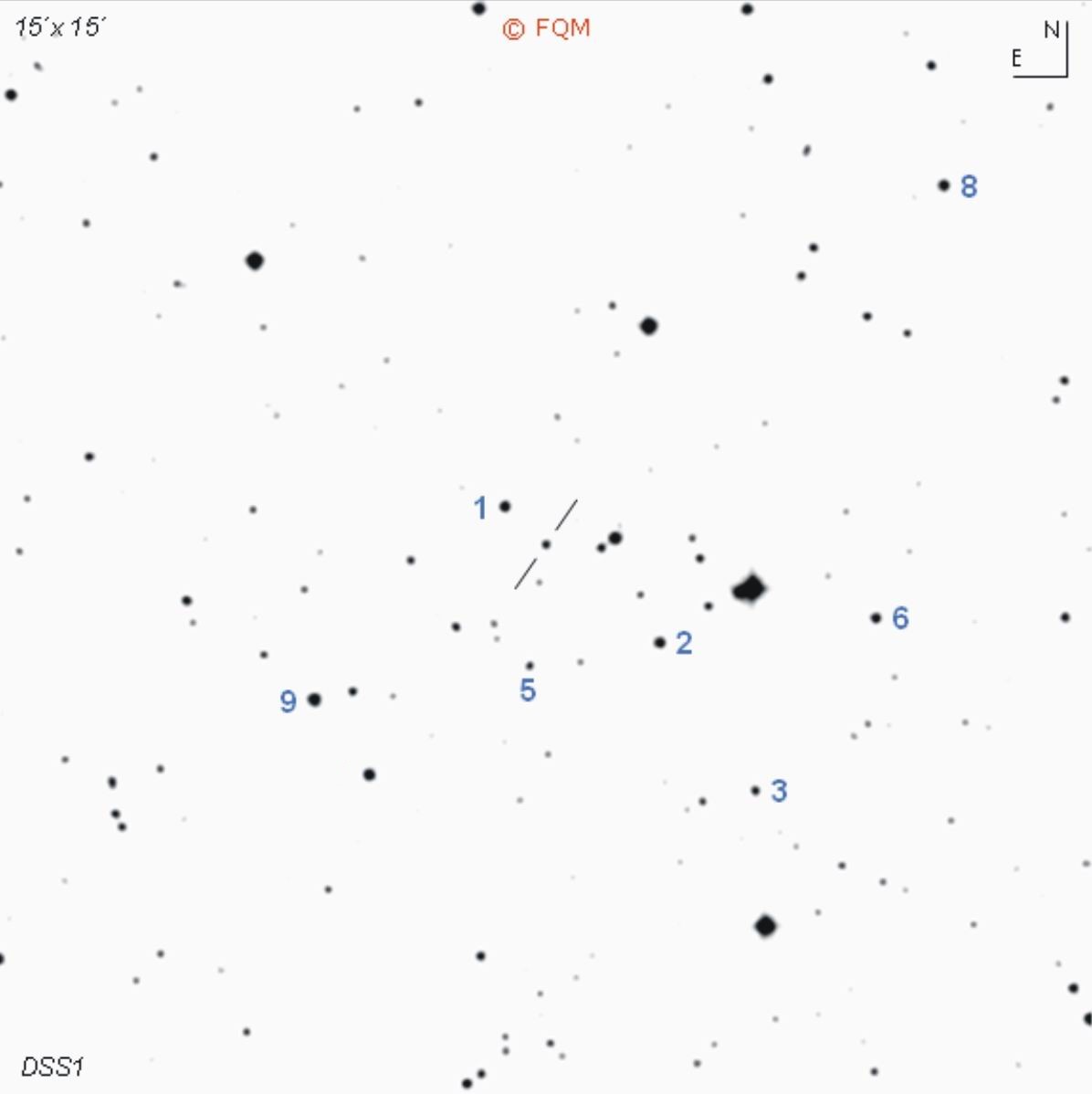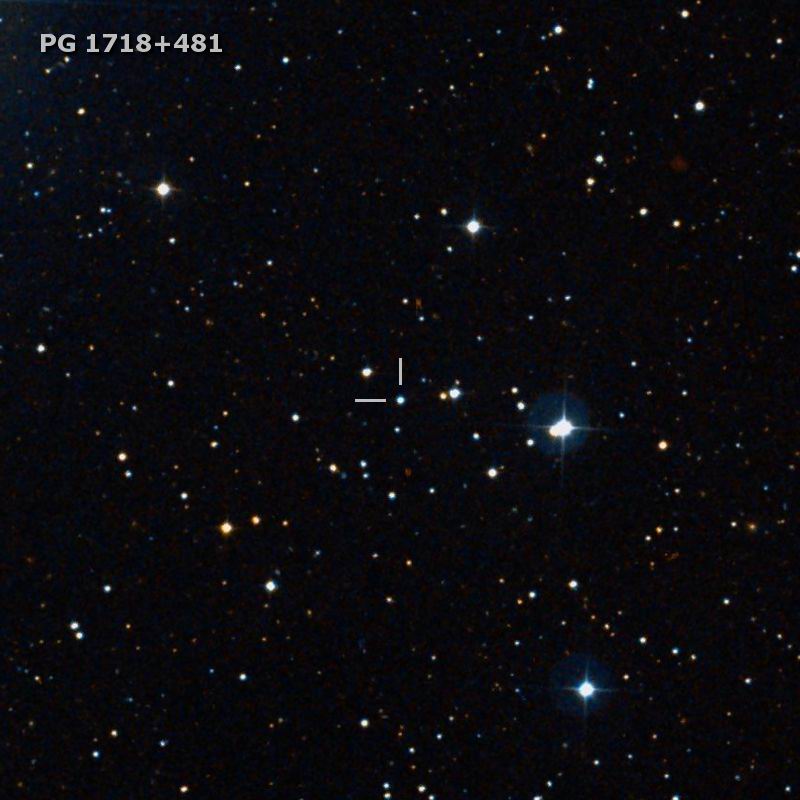
| Frankfurt Quasar Monitoring |
| PG 1718+481 |
| Cross-Identifications | QSO J1719+4804, 1RXS J171937.9+480409 RGB J1719+480, FIRST J171938.2+480412 1AXG J171940+4803, CGRaBS J1719+4804 87GB 1718+4806, MG4 J171935+4804 2MASSi J1719382+480412, 1718+481 GB6 J1719+4804, QSO B1718+481 |
| Equat. coordinates | RA 17 19 38.3 DE +48 04 13 (J2000) |
| Constellation | Hercules |
| Type | QSO |
| Redshift (1) (3) |
z=1.083 |
| Distance (2) (4) |
3424 Mpc |
| Total mag range (mv) (5) (6) | 14.6 - 15.0 |
| Catalog Magnitude (1) | 14.60 |
| Absolute Magnitude (1) | -29.8 MB |
| Light Travel-Time (2) | 7.836 × 109 yrs |

Comparison stars
| star | B | V | Rc | Ic (1) |
| 1 | 14.473
(0.006) |
13.614
(0.004) |
13.115
(0.003) |
12.659
(0.004) |
| 2 | 14.432
(0.006) |
13.581
(0.004) |
13.115
(0.003) |
12.720
(0.004) |
| 3 | 15.288
(0.006) |
14.636
(0.004) |
14.256
(0.003) |
13.916
(0.004) |
| 5 | 16.135
(0.007) |
15.446
(0.004) |
15.041
(0.004) |
14.671
(0.004) |
| 6 | 15.486
(0.007) |
14.261
(0.004) |
13.524
(0.003) |
12.901
(0.004) |
| 8 | 14.199
(0.006) |
13.423
(0.004) |
13.004
(0.003) |
12.647
(0.004) |
| 9 var? | 14.126
(0.006) |
12.971
(0.004) |
12.249
(0.003) |
11.614
(0.004) |


 Exposure
date: 1955, March
25
POSS I, Palomar 48-inch Schmidt / Size 10´× 10´ |
 Exposure
date:
2011,
November 23
Taunus Obs., 60-cm Refl., S. Karge / Size 10´× 10´ |
| PG
1718+481 is a flat-spectrum
radio source in northern Hercules, some 5° SW of
Draco´s head and close to the constellation Draco. The designation PG 1718+481
refers to the Palomar-Green Bright Quasar
Survey (PG), where this object was discovered between 1976 und 1980 as
a
blue stellar object of magnitude B=15m.33. Spectroscopic
investigations revealed broad
emission lines which led to the quasar classification. As
a blue UV-bright object,
this
quasar was also observed by the International Ultraviolet Explorer in
1982. The first ground based observations in the near infrared were
carried
out in 1983 by the 5m-Hale Reflector. Despite the
large distance of nearly 8×109
light-years, a faint diffuse envelope was detected around the bright
stellar source - the first hint of
the host galaxy of PG 1718+481
was found. During
1997-2000, further observations in the infrared
were
undertaken by the 2 Micron All Sky Survey
(2MASS). As
a radio source, PG
1718+481 was first identified in 1987 with the 91-m Green Bank Radio
Telescope (87GB). Since 1990, quasar PG
1718+481 has also been known as
an
X-ray emitter, after its detection by ROSAT (RX). PG 1718+481 has a redshift of z=1.083, which means a light travel-time of 7.8×109 years! This is more than half the way through the observable universe! All together, quasar PG 1718+481 is an interesting object due to its very large cosmological distance, combined with exceptionally high luminosity. PG 1718+481 is a low amplitude variable object with a total range of only about 0.4 magnitudes in the optical, confirmed by data from the literature and the Frankfurt Quasar Monitoring programme. CCD observers, as well as visual observers, shall use the comparison stars given above. Visual observers need at least a 10-inch telescope or larger to glimpse this quasar as a faint stellar object. Even with large instruments the quasar remains stellar. Locating quasar PG 1718+481 is quite easy: Just take the two brightest stars in the head of Draco, Gamma Draconis and Beta Draconis. Take the distance from Gamma Draconis to Beta Draconis. From Beta Draconis, just turn right to the south by the same distance (4.5°). A 6.37-mag field star, 11´NE of the quasar, leads you directly to PG 1718+481. Alternatively, you can draw a line from globular cluster M92 to Beta Draconis in the Draco´s head. Halfway between, you will come across quasar PG 1718+481. ____________
Two interesting deep sky showpieces are worth visiting. The first is M92, a bright globular cluster about 5° to the south. M92 is some 30 000 light-years distant and can be resolved using an 8-inch telescope or larger. Another globular cluster, NGC 6229, can be found 5.5° to the east. NGC 6229 is considered to be about 100:000 light-years away. The brightest stars in NGC 6229 are of mag 15.5, so you will need at least 12- to 14-inch of aperture to resolve some few very faint stars of NGC 6229. Observers who like to hunt down more very old quasi-stellar photons may turn to quasar PG 1700+518, a bright 14-mag object at a distance of about 3×109 light-years, only 4.7° NW. Some 45 arcsecs to the west of the quasar position, a 15.7-mv high proper-motion star can be seen in the images above, designated 2MASS J17193377+4804178. Between 3/1955 and 11/2011 its apparent position changed significantly. 2MASS
J17193377+4804178 (B 16.4, R 14.3), Proper motion -> RA 16 mas/yr,
DE 160 mas/yr.
[Data from CDS Strasbourg Database (6-2013)] |
| Barkhouse, W.A., Hall, P.B. 2001, AJ, 121, 2843; Quasars in the 2MASS Second Incremental Data Release. Bechthold, J., Green, R.F., et al. 1984, ApJ, 281, 76; IUE Observations of High-redshift Quasars. Becker, R.H., White, R.L., et al. 1991, ApJS, 75, 1; A new Catalog of 53.522 4.85 GHz Sources. Doroshenko, V.T., et al. 2007, Ap, 50, 40; BVRI CCD-Photometry of Comparison Stars in the Neighborhoods of Galaxies with Active Nuclei. III. Hansen, T. 1991, Deep Sky Magazine 34, 32; The "Deepest" Deep Sky Objects. Karge, S.; Helle Quasare für 8- bis 10-Zoll Teleskope. Ein Beobachtungsführer zur visuellen Beobachtung von Quasaren und BL Lacertae Objekten; Frankfurt 2005. Kirhakos, S.D., Sargent, W.L.W., et al. 1994, PASP, 106, 646; The HST Quasar Absorption-Line Key Project. VIII. CCD Imaging of Hubble Space Telescope Quasar Fields. Neugebauer, G., Matthews, K., et al. 1985, ApJ, 298, 275; Infrared Photometry of the Nebulosity around Quasars. Richards, G.T., Yanny, B., et al. 1997, PASP, 109, 39R; Quasar Photometry with the SDSS Monitor Telescope. Schmidt, M., Green, R. 1983, ApJ, 269, 352; Quasar Evolution derived from the Palomar Bright Quasar Survey and other complete Quasar Survey. Seronik, G. 1999, Sky & Telescope 10, 126; A serendipitous Discovery. Steidel, C.C., Sargent, W.L.W. 1991, ApJ, 382, 433; Emission-line and Continuum Properties of 92 bright QSOs - Luminosity Dependence and Differences between radio-selected and optically selected Samples. Steinicke, W.; Katalog heller Quasare und BL Lacertae Objekte; Umkirch 1998. Véron-Cetty, M.-P., Véron, P. 2001, A&A 374, 92; A Catalogue of Quasars and Active Nuclei: 10th edition. Véron-Cetty, M.-P., Véron, P. 2003, A&A 412, 399; A Catalogue of Quasars and Active Nuclei: 11th edition. Véron-Cetty, M.-P., Véron, P. 2006, A&A 455, 776; A Catalogue of Quasars and Active Nuclei: 12th edition. Véron-Cetty, M.-P., Véron, P. 2010, A&A 518, 10; A Catalogue of Quasars and Active Nuclei: 13th edition. Voges, W., Aschenbach, B., et al. 1999, A&A, 349, 389; The ROSAT All-Sky Survey Bright Source Catalogue. |
| Link: Hamburg Quasar Monitoring |
| home |